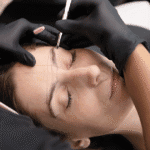Introduction: The Future of Body Sculpting
In the world of body sculpting, non-invasive treatments are gaining popularity for their ability to target stubborn fat and tighten skin without the need for surgery or extensive downtime. Among the most effective methods are laser lipo and radio frequency (RF) technology. These two technologies, when combined, offer a powerful solution for achieving smoother, more sculpted body contours. In this article, we’ll explore how these treatments work individually and synergistically to help you achieve your dream body.
Laser Lipo: Targeting Fat with Precision
Laser lipo, also known as laser lipolysis, is a non-invasive procedure designed to target and break down fat cells. Using low-level laser energy, laser lipo safely penetrates the skin to liquefy fat cells, which are then naturally flushed out by the body’s lymphatic system.
One of the key advantages of laser lipo is its precision. The laser can target specific areas where fat is resistant to traditional exercise or diet. It’s ideal for treating stubborn areas like the abdomen, love handles, thighs, and upper arms. The procedure is quick, with sessions typically lasting between 30 to 60 minutes, depending on the treatment area. The best part? It requires little to no downtime, meaning patients can resume normal activities right after the treatment.
Laser lipo is especially effective for individuals who want to reshape their body contours without the risks and recovery time associated with traditional liposuction.
RF Technology: Tightening Skin & Enhancing Results
While laser lipo targets fat, radio frequency (RF) technology focuses on tightening and firming the skin. RF works by using energy to stimulate collagen production, which helps to tighten loose or sagging skin. As we age, collagen production naturally slows down, contributing to skin laxity. RF technology accelerates collagen remodeling, restoring a firmer, smoother appearance to the treated area.
RF treatments are typically used after laser lipo to improve skin elasticity, especially in areas where the skin may appear loose after fat removal. This technology complements laser lipo by enhancing the results, ensuring that the skin remains tight and youthful after fat reduction. The RF treatment is generally performed in 20 to 30-minute sessions and can be combined seamlessly with laser lipo in a single treatment appointment, making it a convenient option for busy individuals.
Synergistic Power for Better Results
When laser lipo and RF technology are combined, the results are greater than the sum of their parts. laser lipo breaks down the fat, while RF tightens the skin and enhances overall contouring. This synergistic approach is particularly effective for individuals looking to target multiple areas and improve both fat reduction and skin tightening in a single treatment plan.
For instance, laser lipo can break down fat in the abdomen, followed by RF to keep the skin firm and smooth. This approach prevents sagging or loose skin after fat loss, leaving areas toned and smooth. Many patients notice visible results after 1–2 sessions, with improvements continuing for weeks as collagen production increases.
Conclusion: The Ultimate Solution for Your Dream Body
Laser lipo and RF technology together provide a revolutionary, non-invasive solution for body sculpting. Whether you’re targeting stubborn fat or tightening loose skin, this powerful combination is a game-changer. With minimal downtime and noticeable results, laser lipo and RF technology allow you to target multiple areas safely and effectively. Incorporating these treatments into your body sculpting regimen gives you the best of both worlds: fat reduction and skin tightening. When choosing body contouring options, laser lipo and RF technology offer the ideal solution for a slimmer, firmer, and more sculpted body.








